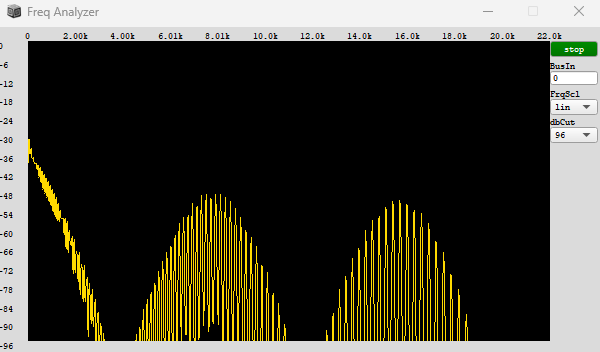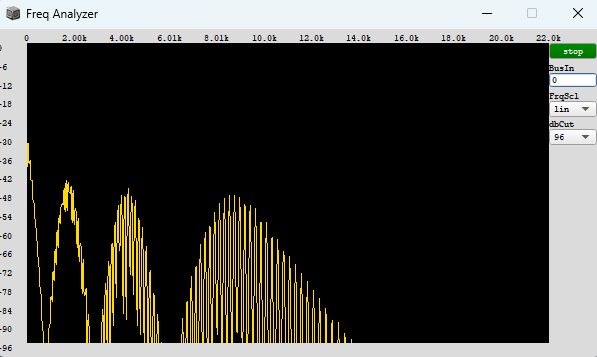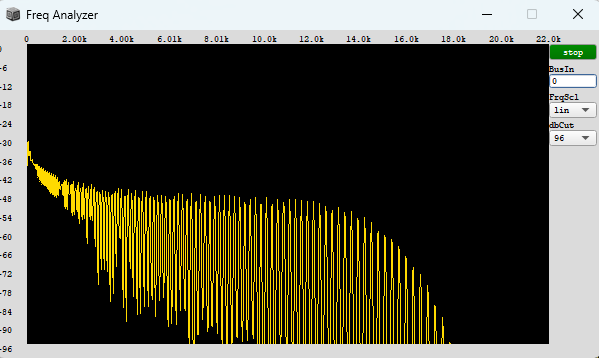Here’s my go at porting a bunch of the Reaktor Razor operators to SC. I’ve translated the functions that I thought looked most interesting / readable. The Reaktor patch is quite difficult to decipher so I’m not 100% on all of it. I had particular trouble understanding how the reverb works, so I gave up on it (plus it uses z-1 sample history). Some of this is not particularly sc idiomatic because I translated one to one best I could from the Reaktor patcher. I also couldn’t quite work out if I am chaining the dissonance operators properly, not entirely sure the freqs are being scaled correctly.
The patch requires LFBrownNoise also.
I might do some of the waveforms next or try and find another way to imitate some of the reverbs.
(
var initChain = { |numPartials, freq|
(
freq: freq,
numPartials: numPartials,
ratios: (1..numPartials),
amps: 1 ! numPartials,
)
};
var addLimiter = { |chain|
var nyquist = SampleRate.ir * 0.5;
var fadeStart = nyquist - 2000;
var limiter = (1 - (chain[\freqs] - fadeStart) / 1000).clip(0, 1);
chain[\amps] = chain[\amps] * limiter;
chain;
};
var makeStretchedHarmonicSeries = { |chain, inharmonicity|
chain[\freqs] = chain[\freq] * chain[\ratios] * (1 + (inharmonicity * chain[\ratios] * chain[\ratios])).sqrt;
chain;
};
// RAZOR Dissonance
var partialDetune = {|chain, amount=0.1, partial_select=2, mode=0|
var idx = chain[\ratios] - 1;
var freq = chain[\freq];
var detune = ((50 / freq) * amount) - mode;
var whichIdx = ((idx / partial_select).floor * partial_select);
var isDetuned = (idx - whichIdx).clip(0,1);
detune = detune * isDetuned;
// detune = (chain[\freq] * (chain[\ratios] + detune));
detune = (chain[\freqs] ? 0) + (chain[\freq] * detune);
chain[\freqs] = detune;
chain;
};
//not sure about this one
var stiffString = {|chain, amount=0.5|
var scaledAmt = amount.linlin(0, 1, -140, 60);
var db2AF = scaledAmt.dbamp;
var idx = chain[\ratios];
var newRatio = (idx.squared * db2AF) + 1;
newRatio = ((log2(newRatio) * 0.5) ** 2) * idx + 1;
//unsure what this should be, unclear in the reaktor patch
// chain[\freqs] = newRatio * chain[\freq];
chain[\freqs] = (chain[\freqs] ? 0) + (chain[\freq] * newRatio);
chain;
};
var centroid = {|chain, amount, targetFreq|
var newRatio;
var partialPitch = chain[\freqs];
var pitchArr = targetFreq ! chain[\numPartials];
newRatio = amount.linlin(0, 1, partialPitch, pitchArr);
chain[\freqs] = newRatio;
chain;
};
//not sure about this one, too many magic numbers
var reverse = {|chain, amount|
var newRatio;
amount = 1 - amount;
newRatio = amount.linlin(0, 1, chain[\ratios].ratiomidi, (321.ratiomidi - 320.ratiomidi) ! chain[\numPartials]).min(200).midiratio;
newRatio = newRatio * chain[\freqs];
chain[\freqs] = newRatio;
//TODO amps
chain;
};
//RAZOR Stereo
//the same(?) as pan2.ar(sig, line).sum but for the sake of completeness:
var panLaw = {|in, pos|
var left = in * (4 - (1 - pos)) * (1 - pos) * 0.333333;
var right = in * (4 - (1 + pos)) * (1 + pos) * 0.333333;
[left, right];
};
//in all examples ramp is the normalised selection of 0-n partial indices
var simplePan = {|sig, chain, amount, ramp|
var partialPitch, pitch, start, length, end;
var rampIndices, centerIndices;
var x0, y0, m0, x, line;
partialPitch = chain[\freqs].cpsmidi;
pitch = chain[\freq].cpsmidi;
start = pitch;
length = ramp.linlin(0, 1, chain[\freqs][0], chain[\freqs][chain[\numPartials]-1]).cpsmidi;
end = length;
rampIndices = 1 - (partialPitch.floor / end.floor).floor.clip(0,1);
centerIndices = (0.5 - rampIndices).clip(0,1);
x0 = end; y0 = 1; m0 = 1/length.max(12); x=partialPitch;
line = ((x - x0 * m0 + y0) * rampIndices * amount) + centerIndices;
line = line.linlin(0,1,-1,1).lag(0.1, 0.1);
panLaw.(sig, line);
};
var autoPan = {|sig, chain, amount, ramp, saw, cycles|
var partialPitch, partialPitchScaled, pitch, start, length, end;
var rampIndices, centerIndices;
var x0, y0, m0, x, line;
//scaling
partialPitch = chain[\freqs].cpsmidi;
partialPitchScaled = partialPitch - 80;
pitch = chain[\freq].cpsmidi;
cycles = ((1-cycles)*30.neg).dbamp * cycles;
partialPitchScaled = partialPitchScaled * cycles;
saw = saw * 0.5.neg;
partialPitchScaled = partialPitchScaled + saw;
partialPitchScaled = partialPitchScaled - partialPitchScaled.collect(_.round);
partialPitchScaled = partialPitchScaled * (8 - (partialPitchScaled.abs * 16));
//panned indices
start = pitch;
length = ramp.linlin(0, 1, chain[\freqs][0], chain[\freqs][chain[\numPartials]-1]).cpsmidi;
end = length;
rampIndices = 1 - (partialPitch.floor / end).floor.clip(0,1);
centerIndices = (1 - rampIndices);
//ramp
x0 = end; y0 = amount; m0 = 1/length.max(12); x=partialPitch;
line = ((x - x0 * m0 + y0) * rampIndices) + centerIndices;
line = line * partialPitchScaled;
line = line.lag(0.1, 0.1);
panLaw.(sig, line);
};
var stereoSpread = {|sig, chain, amount, ramp, saw, cycles|
var idx, partialPitch, partialPitchScaled, pitch, start, length, end;
var rampIndices, centerIndices, spreadIndices;
var x0, y0, m0, x, line;
idx = chain[\ratios];
partialPitch = chain[\freqs].cpsmidi;
partialPitchScaled = partialPitch - 80;
pitch = chain[\freq].cpsmidi;
cycles = ((1-cycles)*30.neg).dbamp * cycles;
partialPitchScaled = partialPitchScaled * cycles;
saw = saw * 0.5.neg;
partialPitchScaled = partialPitchScaled + saw;
partialPitchScaled = partialPitchScaled - partialPitchScaled.collect(_.round);
partialPitchScaled = partialPitchScaled * (8 - (partialPitchScaled.abs * 16));
start = pitch;
length = ramp.linlin(0, 1, chain[\freqs][0], chain[\freqs][chain[\numPartials]-1]).cpsmidi;
end = length;
rampIndices = 1 - (partialPitch.floor / end).floor.clip(0,1);
centerIndices = (1 - rampIndices);
//flip polarity of every second partial
spreadIndices= idx.wrap(0,1).linlin(0,1,-1,1);
partialPitchScaled = partialPitchScaled * spreadIndices;
x0 = end; y0 = amount; m0 = 1/length.max(12); x=partialPitch;
line = ((x - x0 * m0 + y0) * rampIndices) + centerIndices;
line = line * partialPitchScaled;
panLaw.(sig, line);
};
var air = {|sig, chain, amount, speed, min, max|
var idx = chain[\ratios];
var partialFreqs = chain[\freqs];
var noise_L, noise_R;
var idxAmp, rangeAmp, ampScale;
var amtFade, amtMult;
var pan, left, right;
speed = speed.linlin(0,1,-200,0).midiratio;
min = min.linlin(0,1,-70,40);
max = max.linlin(0,1,-70,40);
noise_L = partialFreqs * speed + 0.333;
noise_R = partialFreqs * speed + 0.456;
noise_L = LFBrownNoise2.ar(noise_L, 1, 1, 5);
noise_R = LFBrownNoise2.ar(noise_R, 1, 1, 5);
idxAmp = (chain[\amps] * (idx - 1)).max(0.0001).dbamp - max;
rangeAmp = 1/(max - min).max(0.1).neg;
ampScale = (idxAmp * rangeAmp).clip(0, 1) * amount;
amtFade = (1 - ampScale);
amtFade = (2 - amtFade) * amtFade;
amtMult = (2 - ampScale) * ampScale;
amtMult = amtMult * 2;
noise_L = (noise_L * amtMult) + amtFade;
noise_R = (noise_R * amtMult) + amtFade;
[noise_L * sig, noise_R * sig];
};
//notch
var notchFilter = { |chain, notchFreq, notchWidth|
var freqs = chain[\freqs];
var amps = chain[\amps];
var dist = (freqs - notchFreq).abs;
var attenuation = 1.0 - exp(dist.neg / notchWidth);
chain[\amps] = amps * attenuation;
chain;
};
{
var chain, sig;
chain = initChain.(60, 80);
chain = makeStretchedHarmonicSeries.(chain, 0);
//use one of these
chain = partialDetune.(chain, amount: 0.1, partial_select: 2, mode: 0);
// chain = stiffString.(chain, amount: 0.5);
// chain = centroid.(chain, amount: SinOsc.ar(0.05).unipolar, targetFreq: 500);
// chain = reverse.(chain, amount: SinOsc.ar(0.05).unipolar);
chain = notchFilter.(chain, SinOsc.ar(0.5).linlin(-1,1,50,1000), 1000);
chain = addLimiter.(chain);
sig = SinOsc.ar(
freq: chain[\freqs],
phase: ({ Rand(0, 2pi) } ! chain[\numPartials]),
mul: chain[\amps]
);
//use one of these
//simple
// sig = simplePan.(sig, chain, amount: SinOsc.ar(1).unipolar, ramp: 1);
//these two are quite similar
// sig = autoPan.(sig, chain, amount: SinOsc.ar(1).unipolar, ramp: SinOsc.ar(3).unipolar , saw: LFSaw.ar(0.5).unipolar, cycles: SinOsc.ar(0.1).unipolar);
sig = stereoSpread.(sig, chain, amount: SinOsc.ar(1).unipolar, ramp: 1, saw: LFSaw.ar(0.5).unipolar, cycles: 1);
//the best one...
// sig = air.(sig, chain, amount: 0.5, speed: 0.8, min: 0.1, max: 0.9);
sig = sig * -30.dbamp;
}.play;
)
![]()


